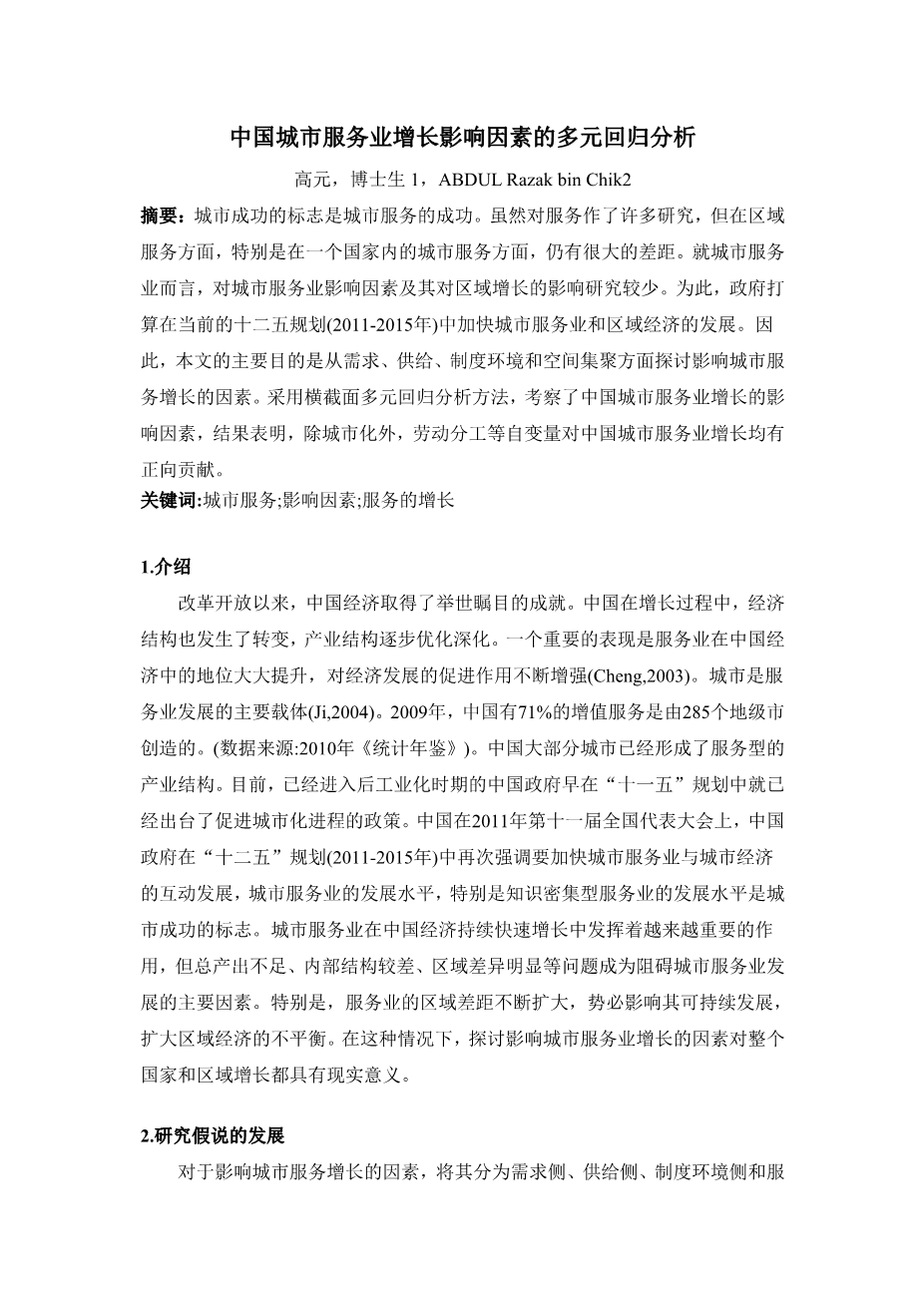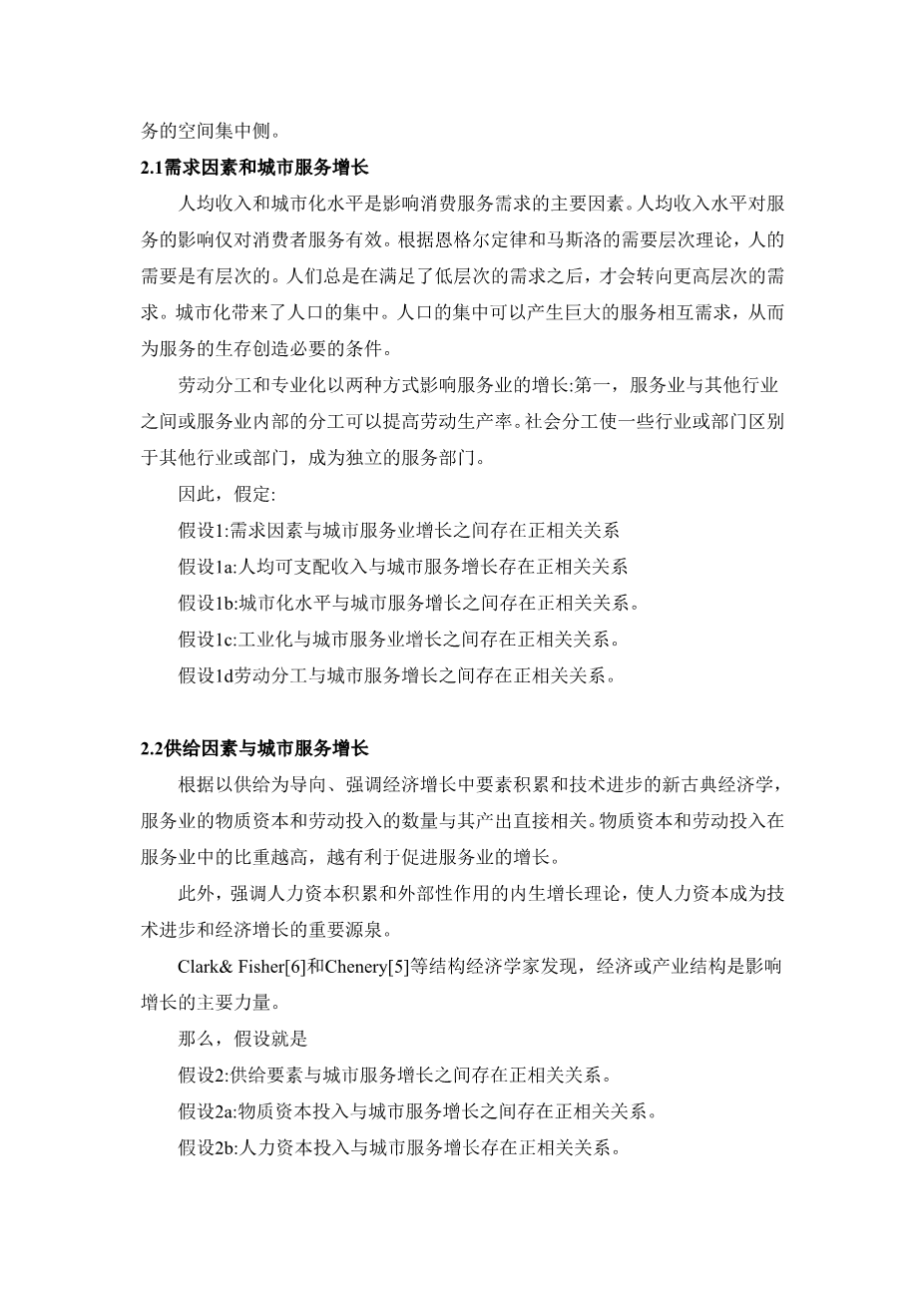A Multiple Regression Analysis on Influencing Factors of Urban Services Growth in China
Yuan Gao, Phd Candidat1, ABDUL Razak bin Chik2
ABSTRACT The indicator of urban success is the success of its urban services. Although much research on services have been made, there is major gap with regard to the regional services, especially on urban services within a country. As for urban ser-vices, there are few research on factors influencing urban services and its effect on regional growth. In reaction to this, the government intend to accelerate the development of urban services and regional economy in the present Twelfth Five-Year Plan 2011-2015.Thus, the main purpose of this paper is to investigate the factors that influence urban servic-es growth from demand , supply, institutional environment and spatial agglomeration side. By using cross-section mul-tiple regression analysis, the study examine the factors influencing urban services growth in China .The model indicated that except for urbanization, division of labor , other independent variables have contributed positively towards urban services growth in China.
Keywords: Urban Services; Influencing Factors; Services Growth
1. Introduction
Since reform and opening up, China has made remarka-ble economic achievements. In the growing process, its economic structure has also undergone a transformation, and its industrial structure has been gradually optimized and deepened. One important manifestation is the status of services in Chinas economy has been greatly en-hanced that their role in promoting economic develop-ment has been growing(Cheng,2003).Urban are the main carrier for servicesrsquo; development(Ji,2004).In 2009,71% of value added services in China was created by 285 ci-ties at prefecture level. (Source of data: China statistical Yearbook, 2010). Most of the cities have formed a ser-vice-oriented industrial structure. At present, China has entered into the post-industrial period, Chinese govern-ment had already come out with policies to promote ur-banization process as early as on the Eleventh Five Year Plan. In the Eleventh National Congress in 2011,Chinese government stressed once again to accelerate the interac-tive development of urban services and urban economy in the Twelfth Five-Year Plan(2011-2015) .The symbol of urban success is the development level of urban ser-vices, especially level of knowledge-intensive services. Urban services are playing an increasingly important role in the sustained and rapid growth of Chinese economy, but problems of inadequate total output, inferior internal structure , apparent regional disparities , have become major resistance in urban servicesrsquo; growth. Especially, the expanding regional gap in services is bound to affect its sustainable development as well as enlarge the im-balance in regional economies. In this case, probing the factors influencing urban services growth have practical significance for the entire country as well as the regional growth.
2. Development of Research Hypotheses As to factors influencing urban services growth, they will be classified into demand, supply, the institutional envi-ronment and servicesrsquo; spatial concentration side.
2.1. Demand factors and Urban Services Growth Per capita income and urbanization level are main factors affecting demand for consumer services. The influence of Per capita income levels on service is only effective on consumer services. According to Engels law and Maslows hierarchy of needs theory, human needs are hierarchical. People will always shift to higher level needs only after meeting the low-level needs. Urbanization has brought the concentration of popula-tion. The concentrated population can generate a huge mutual demand for services, thereby create necessary conditions for servicesrsquo; survival .
The division and specialization of labor affect servic-esrsquo; growth in two ways: First, the division of labor be-tween service and other industries or within services can increase labor productivity.. Social division of labor makes a number of industries or sectors differentiated from other industries or sectors, becoming the indepen-dent service sectors.
It is, therefore, posited that:
Hypothesis 1: There is a positive relationship be-tween demand factors and urban ser-vices growth
Hypothesis 1a: There is a positive relationship be-tween per capita disposable income and urban services growth
Hypothesis 1b: There is a positive relationship be-tween urbanization level and the ur-ban services growth.
Hypothesis1c: There is a positive relationship between industrialization and urban services growth
Hypothesis 1d There is a positive relationship between division of labor and the urban services growth.
2.2. Supply Factors and Urban services Growth
According to new-classical economics, which is supply oriented and emphasizes factor accumulation and tech-nical progress in economic growth, the amount of physi-cal capital and labor input in services are directly related to its output. The higher proportion of physical capital and labor input in services, the more helpful to promote servicesrsquo; growth.
Besides, the endogenous growth theory, which empha-sizes the role of human capital accumulation and exter-nalities, human capital has become an important source of technological progress and economic growth.
The Structural economists, such as Clarkamp; Fisher [6] and Chenery [5], found that the economic or industrial structure was the main force affecting growth.
Then, the hypothesis will be
Hypothesis2: There is a positive relationship between the supply f
剩余内容已隐藏,支付完成后下载完整资料


英语译文共 10 页,剩余内容已隐藏,支付完成后下载完整资料
资料编号:[404907],资料为PDF文档或Word文档,PDF文档可免费转换为Word
以上是毕业论文外文翻译,课题毕业论文、任务书、文献综述、开题报告、程序设计、图纸设计等资料可联系客服协助查找。


